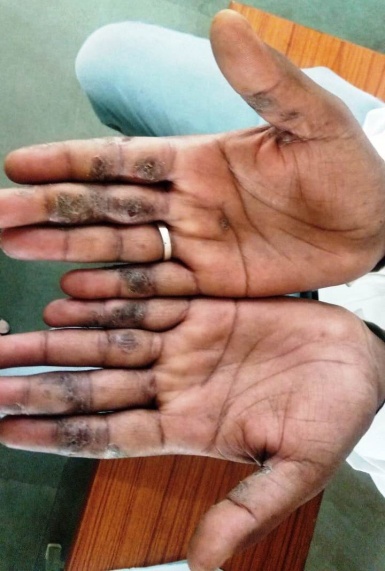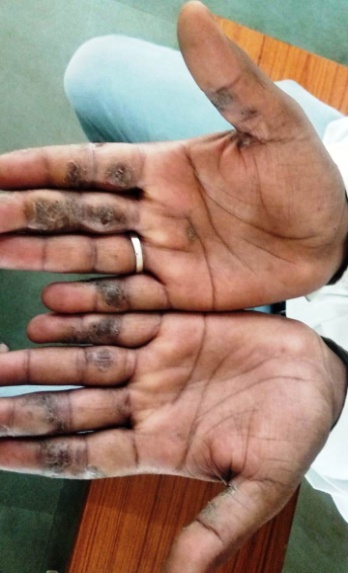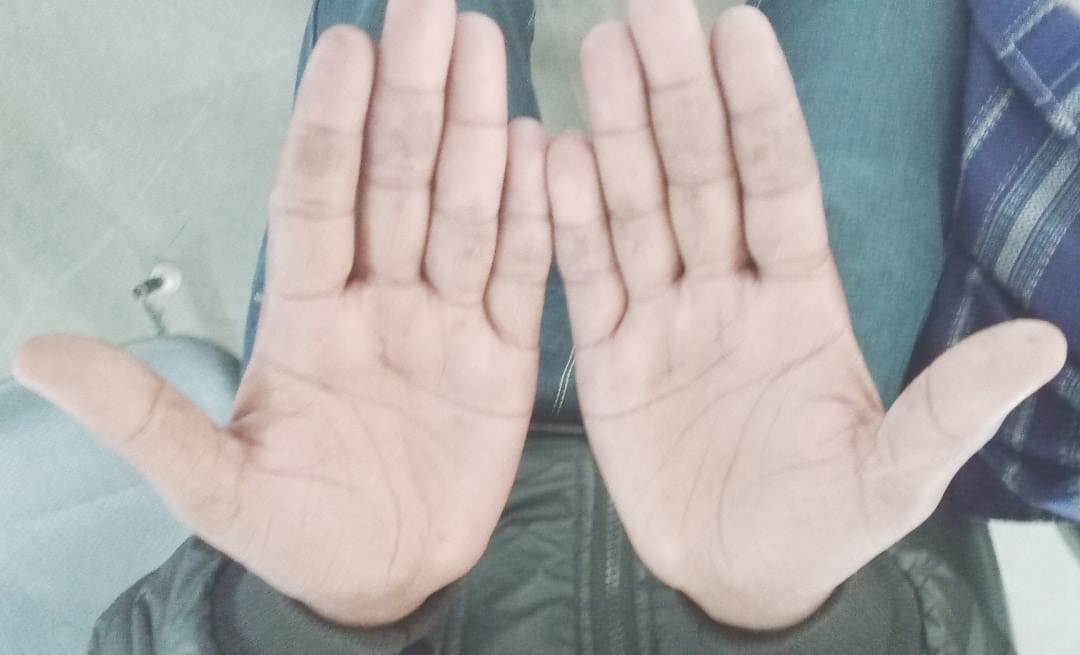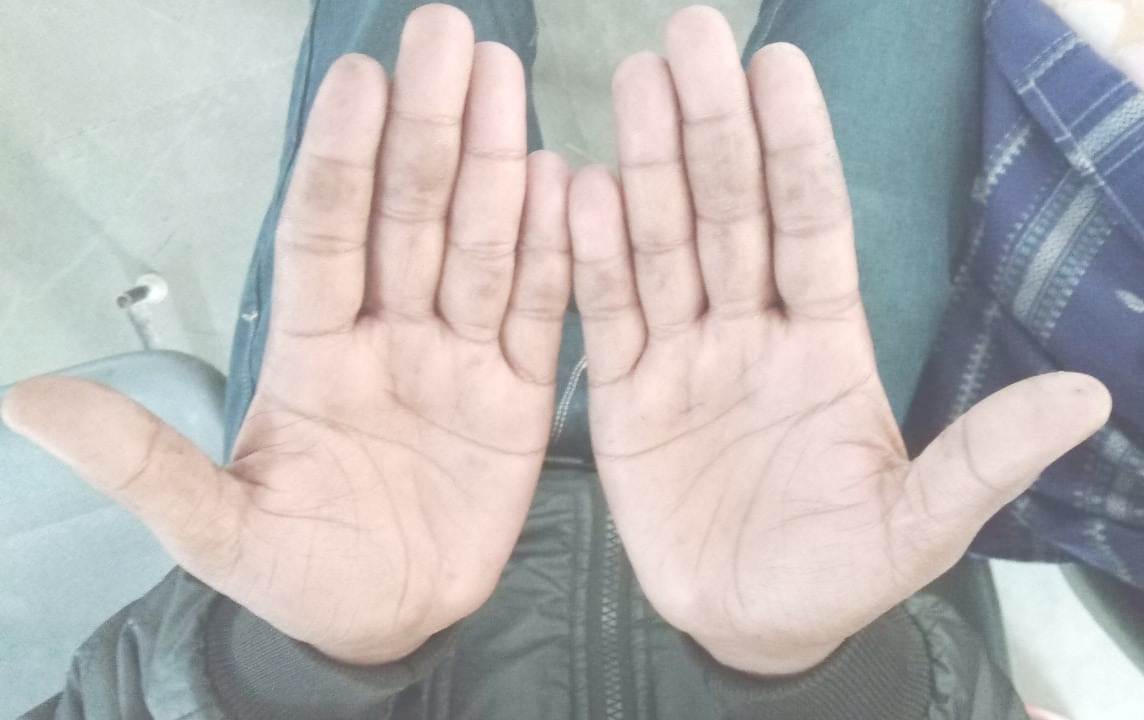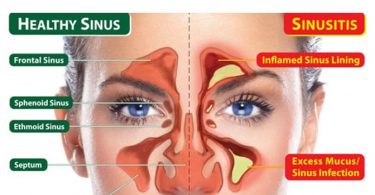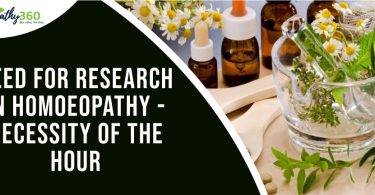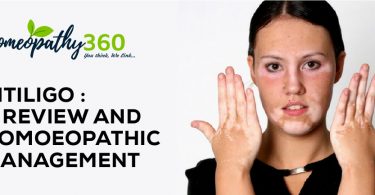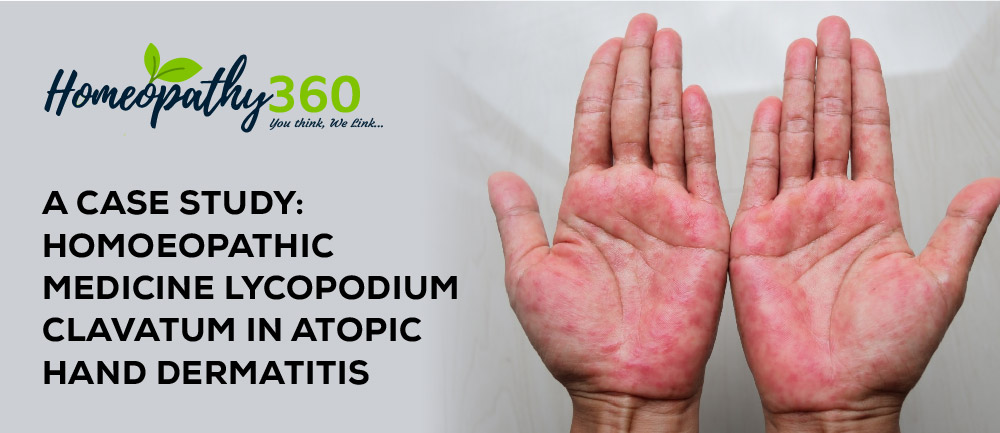
Abstract: Atopic dermatitis (AD) is a chronic, inflammatory skin condition typically affecting the face, neck, arms and legs. AD is usually associated with elevated levels of immunoglobulin E (IgE) and common in children. Although it usually appears during early childhood, it does not always disappear before adulthood, or often suppressed or began in adulthood. Hence called adult onset atopic dermatitis. This case represents a case of adult onset atopic dermatitis treated with homoeopathic remedy Lycopodium. A 40 year old male patient visited OPD on 14/10/2019. He was complaining of eczematous eruption on fingers of both hands with itching and burning with black discoloration since last 5 years. This patient improved with Lycopodium 200, single dose. Firstly offensive discharge and itching disappear then eruptions have cured.
Keywords: Atopic dermatitis, adult onset atopic dermatitis, homoeopathy, Lycopodium clavatum.
Abbreviations: Atopic dermatitis (AD), immunoglobulin E (IgE), outpatient department (OPD).
Introduction: Atopic dermatitis is a common, chronic, relapsing, inflammatory skin disease that primarily affects young children. ‘Atopy’ is defined as an inherited tendency to produce immunoglobulin E (IgE) antibodies in response to minute amounts of common environmental proteins such as pollen, house dust mites, and food allergens. Dermatitis derives from the greek ‘derma’, which meansskin, and ‘itis’ which meansinflammation.1 The term adult-onset atopic dermatitis (onset >18 years) was introduced by Bannister and Freeman.2 AD in adults involves chronic, dark colored, thick, lichenified plaques and sometimes isolated pruritic papules. These patients experience vesicular, oozing discharges and intense itching. In adults, the disease affects different areas of the body compared to infantile manifestations. The hands, face and especially the eyelids are most often involved2.
AD affects about one-fifth of all individuals during their lifetime1. A rising trend in AD has also been observed in India in last four decades. The reported prevalence among dermatology outpatient department attendees being 0.42% and 0.55%3. The prevalence in south India was only 2.8%. Family history has varied in ranging from 36% to 42%.4 With the two- to threefold increase in prevalence of AD over the past few decades, the prevalence of adult-onset AD has also increased and its prevalence ranged from 1-3% in different populations.5
Aetiology includes genetic predisposition, immune system dysfunction, epidermal barrier dysfunction, certain skin infections, allergies to food, chemicals, pollens, mites, etc.6 The pathophysiology of AD is complex and multifactorial, involving elements of barrier dysfunction, alterations in cell mediated immune responses, IgE mediated hypersensitivity, and environmental factors. Loss of function mutations in filaggrin have been implicated in severe atopic dermatitis due to a potential increase in trans-epidermal water loss, pH alterations, and dehydration.7 Diagnostic criteria is usually clinical based upon the pattern of lesions. Pruritus and least three of the following are required: history of itching in skin.
Case profile:
A 40 years old male came in our OPD on 14/10/2019 with the complaints of eczematous eruption on fingers of both hands and black discoloration of fingers with itching which get aggravated at night and cold temperature. There is burning all over the affected part with offensive discharges.
History of present complaints and treatment history:
Patient was apparently well 5 years back then eruption appear on finger of right hand. gradually eruptions increased, after that itching and burning started. Thereafter eruptions started appearing on fingers of left hand. Two months later offensive discharge started from affected area. Patient took allopathic and ayurvedic treatment for last 4 years but got no permanent relief, so they visited our OPD.
Associated symptoms: Patient also suffered fromflatulence and pain abdomen which increase after eating. Flatus was offensive.
Past history: In childhood there was history of allergic rhinitis during harvesting season and change of weather, and various sorts of dermatitis on different parts , which were more often subsided by allopathic medications.
Family history: Son suffers from allergic rhinitis.
Physical generals: The patient has normal appetite has meals twice daily with sweet desire and flatulence after meal, Thermal Reaction was Hot. Perspiration normal, non offensive, non staining. Drink 1.5 – 2 litres of water per day.
Mental generals: The patient was restless. He used to get irritated and angry very often. Desired for company always. he wanted to someone near him always.
Clinical findings: Appearance was ectomorphic, height- 5’6”, weight- 72 kilograms. Other general and systematic examination findings were normal.
Analysis and evaluation of symptoms:
Table 1: Analysis and evaluation of symptoms
| Mental general | Physical general | Particular |
| Irascibility | Flatulence after eating | Eczematous eruption |
| Desire company | Offensive flatus | Black discolouration of fingers |
| Restless | Itching < night | |
| Itching < cold | ||
| Offensive discharge from affected area | ||
| Burning Abdominal pain due to flatulence | ||
| Heaviness in abdomen |
Miasmatic analysis of symptoms:
Table 2: Miasmatic analysis of symptoms. [8][9][10][11][12]
| SYMPTOMS | PSORA | SYCOSIS | SYPHILIS | |
| Irascibility | ||||
| Desire company | ||||
| Restless | ||||
| Eczematous eruption | ||||
| Black discolouration of fingers | ||||
| Itching < night | ||||
| Itching < cold | ||||
| Burning | ||||
| Offensive discharge from affected area | ||||
| Flatulence after eating | ||||
| Offensive flatus | ||||
| Abdominal pain due to flatulence | ||||
| Heaviness in abdomen | ||||
Dominant miasm: PSORA
Fundamental miasm: PSORA
Repertorial totality:
The following rubrics were selected from RADAR 10.0: [13]
- Mind – IRRITABILITY, general
- Mind – COMPANY, general – desire for
- Mind – RESTLESSNESS
- Hands – ECZEMA – eczema, fingers
- Hands – DISCOLORATION, of hands – discoloration, fingers – black
- Hands – ITCHING, hands – night
- Skin – ERUPTIONS – burning
- Skin – ULCERS, general – discharges, from ulcers – offensive
- Intestines – FLATUS, intestinal – eating, after
- Rectum – FLATUS, rectal – offensive
- Abdomen – PAIN, abdomen – flatus, incarcerated, as from
- Abdomen – HEAVINESS, sensation, as from a load, etc.
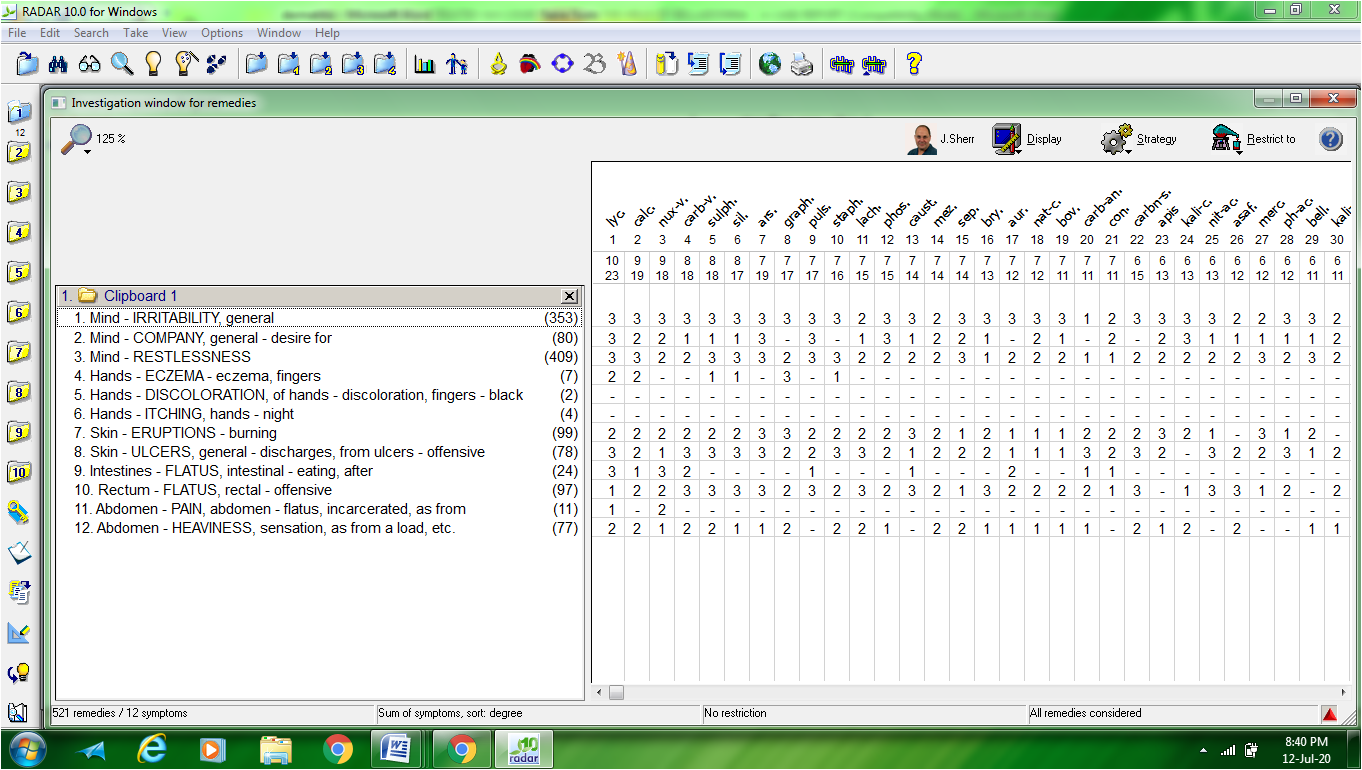
Figure 1: Repertorisation of case from Murphy’s Repertory using RADAR software. [13]
Justification of selection of remedy and potency:
Lycopodium clavatum 200/1dose/stat followed by Phytum for 10 days was first prescription because it covered maximum rubrics with maximum marks after repertorisation. Lycopodium clavatum covered 10 symptoms out of 12, those are irritability, desire company, restlessness, eczema on fingers, burning in eruption, offensive discharge from ulcers, flatulence after eating, offensive flatus, pain abdomen due to increase flatulence, heaviness in abdomen. After comparison of symptoms from various books of materia medica, Lycopodium clavatum appears similimum to the totality of symptoms of the patient. Moderate susceptibility (according to his work and habit) and the medicine covered maximum symptoms, hence 200 potency was selected. [14]
Prescription –
Lycopodium clavatum 200/1dose
Phytum 30/TDS 10 days
Table 3: Follow-ups with prescription and justification
| Date | Follow Up Interpretation | Prescription | Justification |
| 14/10/2019 (1stvisit, case taking done) | Eczematous eruption on fingers of both hands. Black discoloration of fingers. Itching < night , cold Burning+++ Offensive discharge from affected area. Flatulence after eating, offensive flatus. Abdominal pain and heaviness due to flatulence. | Lycopodium clavatum 200/1dose Phytum 30/TDS/10 days | After repertorisation and comparison of symptoms from various books of materia medica, Lycopodium clavatum is simillimum |
| 24/10/2019 | Discharge absent but itching and burning still present. No new eruptions. Slight relief in flatulence and pain abdomen. | Phytum 30/TDS/15 days | Improvement in patient’s symptoms. |
| 08/11/2019 | No discharge, no burning and relief in itching. No new eruptions. No heaviness and pain in abdomen and flatulence decrease | Phytum 30/TDS/20days | Improvement in patient’s symptoms. |
| 29/11/2019 | Relief in almost all symptoms. No new eruptions. On and off episodes of flatulence. | Phytum 30/TDS/20days. Lycopodium 200/ 1dose/SOS | Improvement in patient’s symptoms. |
| 20/12/2019 | General amelioration in all symptoms. Patient didn’t feel the need to take Lycopodium clavatum which was prescribed when required | Phytum 30/TDS/20days | Improvement in patient’s symptoms. |
Figure 2,3: Patient before taking homeopathic treatment
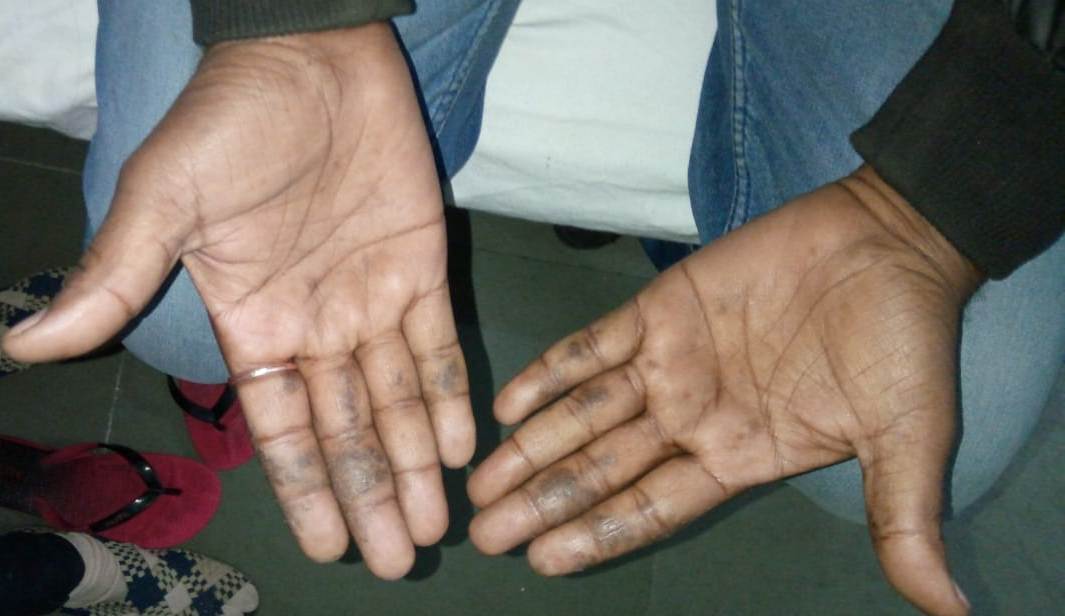
Figure 4: Follow up on 24.10.2019
Figure 5,6: Patient after taking homoeopathic treatment. Follow up on 08.11.2019
Discussion and conclusion: Physical appearance related issues have become almost important for young individuals in this modern era and competitive world. Homoeopathic medicines have a positive effect on various skin disorders. This case confirms significance of single dose and repertorial approach on the basis of totality of symptoms.
References:
- Thomsen SF. Atopic dermatitis: natural history, diagnosis, and treatment. ISRN Allergy. 2014; Published 2014 Apr 2. doi:10.1155/2014/354250.
- Bannister MJ, Freeman S. Adult-onset atopic dermatitis. Australas J Dermatol. 2000;41:225–8.
- Kanwar AJ , De D. Epidemiology and clinical features of atopic dermatitis in India. Indian J Dermatol 2011;56:471-5.
- Kumar S, Nayak CS, Padhi T, Rao G, Rao A, Sharma VK, Srinivas CR. Epidemiological pattern of psoriasis, vitiligo and atopic dermatitis in India: Hospital-based point prevalence. Indian Dermatol Online J 2014;5, Suppl S1:6-8.
- Ozkaya E. Adult-onset atopic dermatitis. J Am Acad Dermatol. 2005;52:579–82.
- Davidson Stanley. Principles & Practice of Medicine. 22nd ed. Philadelphia: Elsevier; 2014.
- Williams HC, Burney PG, Hay RJ, et al. The U.K. Working Party’s Diagnostic Criteria for Atopic Dermatitis. I. Derivation of a minimum set of discriminators for atopic dermatitis. British Journal of Dermatology. 1994;131(3):383–96.
- Patel RP. Chronic miasms in homoeopathy and their cure with classification of their rubrics/symptoms in Dr.Kent’s repertory (repertory of miasms- psora, sycosis, syphilis. Kerala: Hahnemann Homoeopathic Pharmacy; 1996.
- Allen JH. The Chronic Miasms, Psora ,Pseudo Psora and Sycosis. New Delhi: B.Jain Publishers Pvt. Ltd.; 2014.
- Benerjee SK. Miasmatic prescribing, its philosophy, diagnostic classifications, clinical tips, Miasmatic repertory, Miasmatic weightage of medicines and case illustrations. 2nd extended ed. New Delhi: B Jain Publishers Pvt.Ltd; 2011.
- Robert HA. The principles and art of cure by Homoeopathy. 3rd reprint ed. New : B Jain Publishers Pvt.Ltd; 2007.
- Hahnemann S. The chronic diseases their peculiar nature and their homoeopathic cure. Low Price Edition. New Delhi: B. Jain Pulishers Pvt. Ltd.; 2002.
- RADAR [computer program]. Version 10.0. London: Archibel Homeopathic software.
- Mandal PP, Mandal BA. Textbook of Homoeopathic Pharmacy.2nd ed. Kolkata: New Central Book Agency(P)Ltd 2009.
About the authors
Dr Neha Mahawer , MD Scholar, Department of Materia Medica (Hom.) , Dr. M.P.K Homoeopathic Medical College, a constituent college of Homoeopathy University, Jaipur
Dr Bhupendra Arya , MD Scholar, Department of Practice of Medicine (Hom.), Dr. M.P.K Homoeopathic Medical College, a constituent college of Homoeopathy University, Jaipur.


